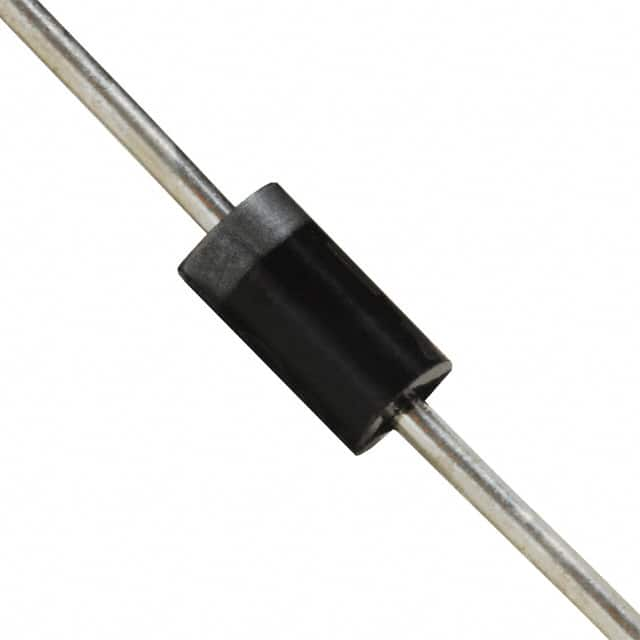BZX85C6V2 Diode Encyclopedia Entry
Product Overview
Category
The BZX85C6V2 diode belongs to the category of Zener diodes.
Use
It is commonly used for voltage regulation and voltage reference applications.
Characteristics
- Zener voltage: 6.2V
- Power dissipation: 1.3W
- Package type: DO-41
- Operating temperature range: -65°C to +200°C
- Forward voltage: 1.5V
- Reverse current: 5µA
Packaging/Quantity
The BZX85C6V2 diode is typically available in tape and reel packaging with quantities varying based on manufacturer specifications.
Specifications
- Zener voltage: 6.2V ±5%
- Power dissipation: 1.3W
- Maximum forward voltage: 1.5V
- Maximum reverse current: 5µA
- Operating temperature range: -65°C to +200°C
- Package type: DO-41
Detailed Pin Configuration
The BZX85C6V2 diode has two pins, with the anode connected to the positive side and the cathode connected to the negative side.
Functional Features
The BZX85C6V2 diode operates as a voltage regulator, maintaining a constant output voltage across a wide range of load currents and temperatures.
Advantages and Disadvantages
Advantages
- Precise voltage regulation
- High power dissipation capability
- Wide operating temperature range
Disadvantages
- Limited voltage options compared to programmable voltage references
- Sensitive to temperature variations
Working Principles
The BZX85C6V2 diode works based on the Zener effect, where it maintains a nearly constant voltage across its terminals when reverse-biased at its specified breakdown voltage.
Detailed Application Field Plans
The BZX85C6V2 diode finds application in various fields such as: - Voltage regulation in power supplies - Overvoltage protection in electronic circuits - Voltage reference in precision measurement equipment
Detailed and Complete Alternative Models
Some alternative models to the BZX85C6V2 diode include: - 1N4738A (8.2V Zener diode) - BZX55C6V2 (6.2V Zener diode) - 1N5349B (12V Zener diode)
This comprehensive entry provides detailed information about the BZX85C6V2 diode, covering its category, use, characteristics, package, specifications, pin configuration, functional features, advantages and disadvantages, working principles, application field plans, and alternative models, making it a valuable resource for engineers and enthusiasts alike.
Lista 10 Vanliga frågor och svar relaterade till tillämpningen av BZX85C6V2 i tekniska lösningar
What is the maximum power dissipation of BZX85C6V2?
- The maximum power dissipation of BZX85C6V2 is 1.3W.
What is the voltage tolerance of BZX85C6V2?
- The voltage tolerance of BZX85C6V2 is ±5%.
What is the operating temperature range for BZX85C6V2?
- The operating temperature range for BZX85C6V2 is -65°C to +175°C.
What is the typical forward voltage drop of BZX85C6V2?
- The typical forward voltage drop of BZX85C6V2 is 1.2V at 200mA.
What is the reverse leakage current of BZX85C6V2 at its maximum rated voltage?
- The reverse leakage current of BZX85C6V2 at its maximum rated voltage is 5µA.
Can BZX85C6V2 be used in voltage regulation applications?
- Yes, BZX85C6V2 can be used in voltage regulation applications due to its stable zener voltage.
Is BZX85C6V2 suitable for overvoltage protection in electronic circuits?
- Yes, BZX85C6V2 is suitable for overvoltage protection in electronic circuits due to its ability to maintain a constant voltage across its terminals.
What are the typical applications of BZX85C6V2 in technical solutions?
- BZX85C6V2 is commonly used in voltage stabilization, surge suppression, and voltage reference applications.
What is the zener impedance of BZX85C6V2 at a specified current?
- The zener impedance of BZX85C6V2 at a specified current is typically 5Ω.
Can BZX85C6V2 be used in automotive electronics?
- Yes, BZX85C6V2 can be used in automotive electronics for voltage regulation and overvoltage protection purposes.


